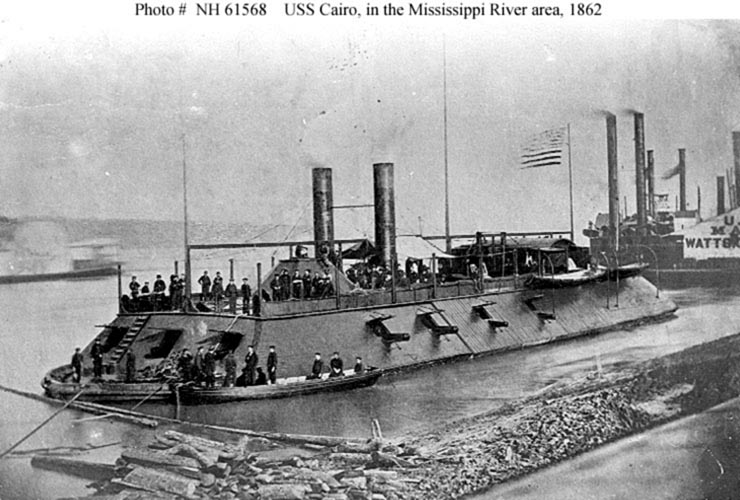USS Cairo is considered the lead ship of the city-class casemate ironclads. It was built at the start of the Civil War, and served as river gunboats. The name Cairo was named for Cairo, Illinois. She captured the Confederate garrison of Fort Pillow along the Mississippi River, which enabled the Union forces to occupy Memphis. In 1862 on December 12, she was sunk during an expedition while clearing mines to attack Haines Bluff. The Cairo was the first to be sunk by a mine remotely by hand. Its’ remains can be viewed at Vicksburg National Military Park, along with weapons and naval stores.
During the Civil War, Cairo was constructed by James Eads and Company, Mound City Illinois that was under contract. The US Department of War. It was for the part of the Union’s Army’s Western Gunboat flotilla. US Navy Lieutenant James M. Prichett was in command then. The Cairo was with the army’s western gunboat flotilla which was on the Mississippi and Ohio rivers. This was until the Cairo was ordered to be transferred to the Navy in October 1862. She was commanded by flag officer Andrew Hull Foote.

The Cairo was active in the occupation of Clarksville, Tenn on Feb 17th 1862 and also in Nashville. The Cairo stood down the river on April 12th whereby escorting mortar boats to start off the lengthy operations against Fort Pillow.
There was an engagement with Confederate gunboats at Plum Point Bend on May 11th that began a series of blockades and bombardments that eventually resulted in the abandonment of the fort by defenders on June 4th. Two days later on June 6 1862 the Cairo joined with the celebration of seven union ships along with a tug, and over eight confederate gunboats off Memphis. Five of the opposing gunboats were either sunk or ran ashore. That night the union forces took over the city. The Cairo then returned to begin patrolling the Mississippi river until Nov 21st when she joined the Yazoo Pass expedition.
In 1862, on December 12th Cairo was clearing mines from the river, readying to attack on Haines Bluff. She struck a torpedo (naval mine). There were volunteers hiding behind the riverbank that detonated it. The Cairo sank in 12 minutes but no casualties occurred on board. The armament on the Cairo had been upgraded overtime. The other city-class ships began to be fitted with what was on hand, and as new pieces were available to be had. Weapons, such as the 32-pounders, or modified 42-pounder rifles were old smoothbores, and made into rifles. The 42-pounders were of concern to the military, since they were structurally weaker, and more apt to explode than the rifled cannons. The 12-pounder howitzer was made to work well during close combat on the rivers, due to the threats of boarding parties. The 12-pounder was not used in regular combat however.
Over time, the Cairo was found. It was covered by silt and sand and impacted in mud. Her artifacts were found and were preserved from corrosion. Where the ship was, was a matter of speculation, since crew members were no longer around as well as the residents themselves were unsure of the location.
